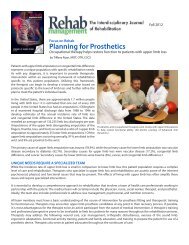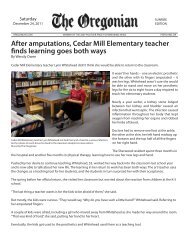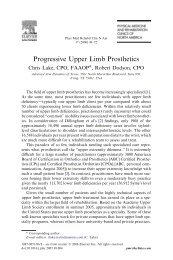Therapeutic Influences on the Upper-Limb Amputee - Advanced Arm ...
Therapeutic Influences on the Upper-Limb Amputee - Advanced Arm ...
Therapeutic Influences on the Upper-Limb Amputee - Advanced Arm ...
Create successful ePaper yourself
Turn your PDF publications into a flip-book with our unique Google optimized e-Paper software.
in size between <strong>the</strong> two groups, most of <strong>the</strong> literature<br />
and resources available for amputees are unintenti<strong>on</strong>ally<br />
focused <strong>on</strong> lower-limb c<strong>on</strong>cerns. Since<br />
upper-limb amputees are looking for resources and<br />
informati<strong>on</strong> specific to <strong>the</strong>ir questi<strong>on</strong>s, it can become<br />
disheartening to reach out and find no answers.<br />
All amputees experience <strong>the</strong> restructuring of how<br />
<strong>the</strong>y view <strong>the</strong>mselves post-amputati<strong>on</strong>. Compounded<br />
by <strong>the</strong> inability to completely c<strong>on</strong>ceal a hand pros<strong>the</strong>sis or a<br />
missing limb, upper-limb amputees have <strong>the</strong> unique situati<strong>on</strong><br />
of c<strong>on</strong>stantly having <strong>the</strong>ir physical difference exposed. Bodyimage<br />
issues impact upper-limb amputees in a different way<br />
since hands are quite visible in day-to-day life and hold cultural<br />
significance as well. It is standard practice in Western culture<br />
to extend <strong>the</strong> right hand to shake hands and to display wedding<br />
rings <strong>on</strong> <strong>the</strong> left hand. Having to alter how <strong>the</strong>y participate in<br />
<strong>the</strong>se cultural practices may be a reminder of <strong>the</strong> loss <strong>the</strong>y<br />
have experienced and may open <strong>the</strong>m up to discriminati<strong>on</strong><br />
and feeling stigmatized by society. Bilateral arm amputees<br />
are even more impacted by this since people are not sure<br />
how to shake <strong>the</strong>ir hands or pros<strong>the</strong>ses. Although individuals<br />
with disabilities—regardless of <strong>the</strong> type of disability—are<br />
c<strong>on</strong>fr<strong>on</strong>ted daily with <strong>the</strong> positive and negative impact of<br />
<strong>the</strong>ir abilities, <strong>the</strong>re are certain ramificati<strong>on</strong>s when individuals<br />
Unlike lower-limb patients, when upperlimb<br />
amputees lose <strong>the</strong>ir dominant side, <strong>the</strong>y<br />
essentially have to relearn how to do even<br />
<strong>the</strong> simplest tasks.<br />
can never choose to feel invisible or take a break from <strong>the</strong>ir<br />
difference. Even positive attenti<strong>on</strong> focused <strong>on</strong> how <strong>the</strong>y are<br />
able to operate within <strong>the</strong>ir disability can be emoti<strong>on</strong>ally<br />
taxing over time.<br />
Functi<strong>on</strong>ality of tasks is impacted by <strong>the</strong> loss of an upper<br />
limb. The varying grasping patterns and dexterity abilities of<br />
<strong>the</strong> human hand can be difficult to replace. Many daily activities<br />
are eased by having two hands to perform <strong>the</strong> task. Depending<br />
up<strong>on</strong> <strong>the</strong> level of amputati<strong>on</strong>, o<strong>the</strong>r sustaining injuries, and<br />
pros<strong>the</strong>tic opti<strong>on</strong>s available, learning to perform certain tasks<br />
can be a l<strong>on</strong>g process requiring intense occupati<strong>on</strong>al <strong>the</strong>rapy.<br />
Unlike lower-limb patients, when upper-limb amputees lose<br />
<strong>the</strong>ir dominant side, <strong>the</strong>y essentially have to relearn how to<br />
do even <strong>the</strong> simplest tasks. The loss of <strong>the</strong> dominant hand can<br />
have a profound impact since it alters ways in which upperlimb<br />
amputees may have identified <strong>the</strong>mselves, such as <strong>the</strong>ir<br />
Supplement of The O&P EDGE June 2008 ■ The Academy TODAY A-5










